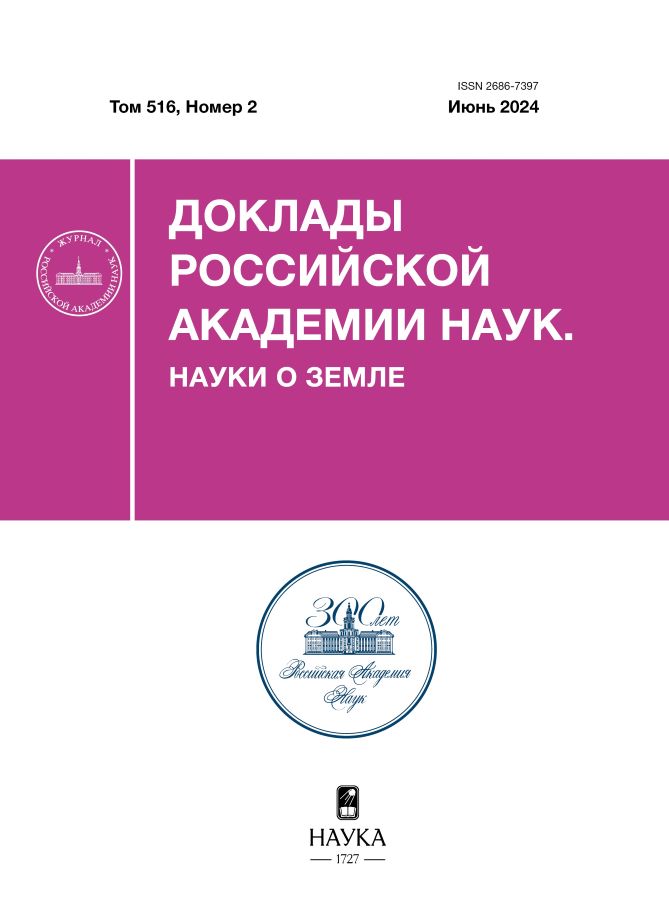Composition and thermochronology of alkaline granites of Ingur massif: to problem of detection of factors contributing to formation of rare-metal mineralization in alkaline granites of Western Transbaikalia
- Authors: Lykhin D.A.1, Yarmolyuk V.V.1, Vorontsov A.A.2, Magazina L.O.1
-
Affiliations:
- Institute of Geology of Ore Deposits, Petrography, Mineralogy, and Geochemistry, Russian Academy of Sciences
- A.P. Vinogradov Institute of Geochemistry, Siberian Branch of the Russian Academy of Sciences
- Issue: Vol 516, No 2 (2024)
- Pages: 543-557
- Section: PETROLOGY
- Submitted: 31.01.2025
- Published: 12.12.2024
- URL: https://edgccjournal.org/2686-7397/article/view/650042
- DOI: https://doi.org/10.31857/S2686739724060066
- ID: 650042
Cite item
Abstract
The article considers the question of what factors contributed to the formation of rare metal mineralization in alkaline granites of Western Transbaikalia. It is based on the results of comparison of petro-geochemical characteristics of alkaline granitoids of nearby ore-bearing Ingur and ore-free Sherbakhtinsky massifs. The rocks of these massifs form a common series of compositions with variations from syenites to alkaline granites (in the Sherbakhtinsky massif) and from alkaline granites to pegmatites (in the Ingur massif). The formation of this series of rocks is associated with a deep differentiation of the original magma common to both massifs, accompanied by a sequential decrease in magnesiality and the accumulation of rare elements (Be, Ta, Nb, Th, U, HREE) in residual melts. They reach the highest values in the pegmatites of the Ingur massif, in which rare metal mineralization appears. Its formation is associated with the fact that, according to thermochronological studies, the Ingur massif for 6 million years was located in the temperature range from 900° to 500°. Such a long stay in the region of high temperatures was accompanied not only by deep differentiation of residual melts, but also stimulated fluid activity, which contributed to the redistribution and accumulation of ore elements in pegmatites.
Full Text
About the authors
D. A. Lykhin
Institute of Geology of Ore Deposits, Petrography, Mineralogy, and Geochemistry, Russian Academy of Sciences
Author for correspondence.
Email: lykhind@rambler.ru
Russian Federation, Moscow
V. V. Yarmolyuk
Institute of Geology of Ore Deposits, Petrography, Mineralogy, and Geochemistry, Russian Academy of Sciences
Email: lykhind@rambler.ru
Academician of the RAS
Russian Federation, MoscowA. A. Vorontsov
A.P. Vinogradov Institute of Geochemistry, Siberian Branch of the Russian Academy of Sciences
Email: lykhind@rambler.ru
Russian Federation, Irkutsk
L. O. Magazina
Institute of Geology of Ore Deposits, Petrography, Mineralogy, and Geochemistry, Russian Academy of Sciences
Email: lykhind@rambler.ru
Russian Federation, Moscow
References
- Воронцов А. А., Ярмолюк В. В. Северо-Монгольская-Забайкальская полихронная рифтовая система (этапы формирования, магматизм, источники расплавов, геодинамика) // Литосфера. 2004. № 3. С. 17–32. https://www.lithosphere.ru/jour/article/view/354
- Занвилевич А. Н., Литвиновский Б. А., Андреев Г. В. Монголо-Забайкальская щелочногранитоидная провинция. М.: Наука, 1985. 232 с. https://search.rsl.ru/ru/record/01001255739
- Tsygankov A. A., Khubanov V. B., Udoratina O. V., et al Alkaline granitic magmatism of the Western Transbaikalia: Petrogenetic and geodynamic implications from U-Pb isotopic–geochronological data // Lithos. 2021. P. 390–391. 106098. https://doi.org/10.1016/j.lithos.2021.106098.
- Ярмолюк В. В., Козловский А. М., Травин А. В., и др. Длительность формирования и геодинамическая природа гигантских батолитов Центральной Азии: данные геологических и геохронологических исследований Хангайского батолита // Стратиграфия. Геологическая корреляция. 2019. Т. 27. № 1. С. 79–102. https://doi.org/10.31857/0869-592X27179-102
- Булнаев К.Б., Карманов Н.С. Редкометальное оруденение в шлировых пегматитах Ингурского массива щелочных гранитов (Западное Забайкалье) // Геология и разведка. 2005. № 2. С. 24–28. https://repository.geologyscience.ru
- Ярмолюк В.В., Кузьмин М.И. Позднепалеозойский и раннемезозойский редкометальный магматизм Центральной Азии: этапы, области и обстановки формирования // Геология рудных месторождений. 2012. Т. 54. № 5. С. 375–399. https://naukarus.com/pozdnepaleozoyskiy-i-rannemezozoyskiy-redkometalnyy-magmatizm-tsentralnoy-azii-etapy-oblasti-i-obstanovki-formirovaniya
- Горжевская С.А., Луговской Г.П., Сидоренко Г.А. Первая находка Самирезида в Советском Союзе // Докл. АН СССР. 1965. Т. 162. № 5. С. 1148–1151.
- Рампилова М.Н., Рампилов М.О. Избродин И.А. Особенности вещественного состава и возраст щелочных гранитов Ингурского массива, Западное Забайкалье // Геодинамик и тектонофизика. 2022. V. 13. I. 4. ARTICLE 0647. https://doi.org/10.5800/GT-2022-13-4-0647
- Государственная геологическая СССР масштаба 1:200 000. Лист N-49-XXIV. Объяснительная записка. М.: ВСЕГЕИ, 1965.
- Травин А.В., Бовен А., Плотников А.В. и др. датирование пластических деформаций в Иртышской сдвиговой зоне (Восточный Казахстан) // Геохимия. 2001. № 12. С. 1347–1351.
- Sun S.S, McDonough W.F. Chemical and isotopic systematic of oceanic basalts: implications for mantel composition and processes: magmatism in ocean basalts / Eds. A.D. Saunders, M.J. Norry. London: Geolog. Soc. (Spec. Publ.), 1989. V. 42. P. 313–346. https://doi.org/10.1144/GSL.SP.1989.042.01.19
- Андреева И.А., Борисовский С.Е., Ярмолюк В.В. Комендитовые расплавы раннемезозойской бимодальной ассоциации Сант (Центральная Монголия) и механизмы их формирования // Доклады РАН. 2018. Т. 481. № 4. https://www.elibrary.ru/item.asp?id=36516766
- Перетяжко И.С., Савина Е.А., Карманов Н.С. Комендиты и пантеллериты вулкана Немрут (Восточная Турция): условия образования и взимосвязи между трахит-комендитовыми, комендитовыми и пантеллеритовыми расплавами // Петрология. 2015. Т. 23. № 6. С. 624–672. https://www.elibrary.ru/item.asp?id=24187511
Supplementary files

















